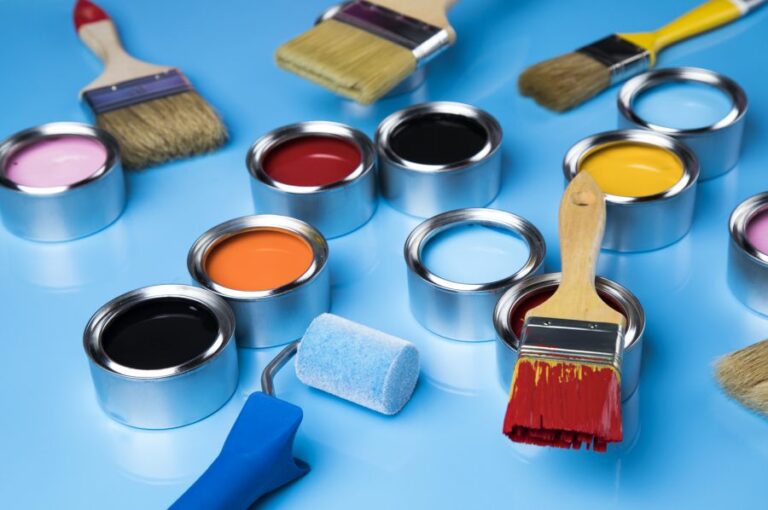Outdoor Paint Markers, 25 Things You Should Know
Are you looking for a creative and durable way to add flair to your outdoor space? Look no further; outdoor paint markers are the perfect solution to transform any surface into a vibrant, eye-catching canvas. Whether it’s for personalization, decoration, or art projects, we’ve got your back and will guide you through the benefits and usage of these versatile markers.
Outdoor paint markers:
Outdoor paint markers are highly pigmented, permanent markers designed for outdoor applications on surfaces like metal, plastic, glass, and outdoor signs. They feature durable, waterproof, and weather-resistant ink that withstands harsh conditions and varying temperatures. When choosing paint markers, key factors include pigment quality, water resistance, weather resistance, surface compatibility, drying time, odor, toxicity, price, and brand.

Discover a world of creativity with outdoor paint markers! Perfect for every project under the sun, these versatile tools bring your ideas to life on any surface. Intrigued? Keep reading for more exciting insights and unleash the artist within!
Contents
- 1 Exterior Paint Markers for Outdoor Use
- 2 Exploring the Distinctions: What are the Key Differences Between Paint Pens and Paint Markers?
- 3 Which Paint Markers Offer Permanent Solutions?
- 4 Is it Possible to Wash Off Paint Markers?
- 5 What are the distinctions between acrylic markers and paint markers?
- 6 Can Oil-Based Paint Markers Be Removed?
Exterior Paint Markers for Outdoor Use
Paint markers are versatile and convenient tools for artists, DIY enthusiasts, and anyone who wants to add a touch of creativity to their outdoor projects. They can be used on a variety of surfaces, such as metal, plastic, glass, and even outdoor signs.
• What Are Outdoor Paint Markers?
Outdoor paint markers are highly pigmented, permanent markers specifically designed for outdoor applications. These markers are made with durable, waterproof, and weather-resistant ink that can withstand the elements and provide long-lasting colors.
Because of their unique formulation, they’re ideal for creating art or adding text on surfaces that are exposed to harsh weather conditions and varying temperatures. Common uses include:
- Graffiti art
- Sign writing
- Outdoor banners and advertisements
- Decorative projects on fences, walls, or other outdoor surfaces
- Automobile customization
• Key Features of Outdoor Paint Markers
– Pigment Quality
The intensity and saturation of color produced by paint markers are determined by the pigment quality. High-quality, vibrant pigments will make your artwork stand out and are less likely to fade with exposure to sunlight and the elements.
By choosing a paint marker with excellent pigment quality, you ensure that your art remains brilliant and eye-catching for extended periods.
– Water Resistance
Outdoor paint markers typically use water-resistant, permanent ink that can withstand rain, humidity, and other moisture-related conditions. This prevents your artwork from smudging or washing away when exposed to water, making it suitable for outdoor applications.
– Weather Resistance
The durability of paint markers is determined by their resistance to weather conditions. Good outdoor paint markers are resistant to extreme temperatures, sunlight, and humidity, ensuring that your art won’t crack, peel, or fade over time.
– Range of Colors and Tip Sizes
Paint markers typically come in a wide range of colors and tip sizes, allowing you to choose the perfect combination for your project. The more options you have at your disposal, the more creative and detailed your artwork can be.
• Choosing the Right Outdoor Paint Markers
When selecting paint markers for outdoor use, consider the following factors:
– Surface Compatibility
Ensure that the marker is compatible with the surface you plan to work on. Most outdoor paint markers work well on various materials, but it’s always best to test on a small, inconspicuous area to ensure that it adheres properly and doesn’t damage the surface.
– Drying Time
Some paint markers dry quickly, while others require more time to set. Choose a marker with a suitable drying time for your project to avoid smudging and ensure a clean finish.
– Odor and Toxicity
Paint markers can have an odor, and some contain toxic chemicals that can be harmful if inhaled or ingested. Look for markers labeled as low-odor or non-toxic, especially when planning to use them in areas frequented by children or pets.
– Price and Brand
The cost of paint markers can vary significantly depending on the brand and quality. It’s vital to strike a balance between affordability and quality, as cheap, low-quality markers may not provide the desired results or lasting effects.
I recommend investing in renowned brands such as Montana Colors or Posca, as they offer high-quality, durable, weather-resistant markers that are perfect for outdoor useI’ve personally experienced great results with these brands.
• Tips for Using Outdoor Paint Markers
– Preparation
Before applying paint markers to outdoor surfaces, ensure that the area is clean, dry, and free of dust or debris. This ensures optimal adhesion and helps the paint last longer.
– Shake Well
To achieve the best results, shake your paint markers well before use. This allows the pigment and the base to mix, ensuring consistency and smooth application.
– Test on a Similar Surface
Before applying the paint marker to the final surface, test it on a similar material to assess how the ink behaves and dries. This can help you avoid surprises in your finished project.
– Store Properly
To prolong the life of your paint markers, store them horizontally and away from direct sunlight or extreme temperatures. This helps to keep the ink from separating or drying out.
– Safety Precautions
Follow any safety instructions the paint marker’s manufacturer provides, such as wearing gloves, and masks or working in a well-ventilated area.
• Conclusion
Outdoor paint markers offer a unique and creative way to add color and flair to various outdoor surfaces, from street art to custom signage. By selecting high-quality, water-resistant, and weather-durable markers, you can ensure that your artwork remains vibrant and eye-catching for a long time.
Exploring the Distinctions: What are the Key Differences Between Paint Pens and Paint Markers?
As an experienced artist, I understand that it is essential to choose the right tools to create the perfect piece, be it a simple sketch or a full-blown masterpiece.
• Paint Pens: The Versatile Choice for Detail and Precision
A paint pen, also known as a paint marker or simply a paint pen, uses a valve system to release the paint from a small nib or tip. These pens can be filled with various types of paint, including acrylic, oil-based, or water-based paints.
You can use paint pens on a wide array of surfaces, including canvas, wood, paper, glass, and metal.
– Pros of Using Paint Pens
There are several advantages to using paint pens in your artwork:
- Precision: Paint pens allow you to create intricate details and precise lines. The fine tips provide you with more control when compared to traditional paintbrushes, making them an ideal tool for artists who want to focus on detailed work.
- Consistency: Paint pens can deliver consistent lines and coverage, eliminating the need to dip your brush in paint frequently.
- Versatility: Paint pens can work on various surfaces and materials, opening up new possibilities for your artwork.
I recommend: Sharpie Oil-Based Paint Markers for beginners and professionals alike, as they offer an excellent balance of quality and affordability.
– Cons of Using Paint Pens
There are some drawbacks to using paint pens:
- Limited Color Range: One downside to paint pens is that their color range is often limited when compared to traditional paint options. However, some brands offer a more extensive selection of colors.
- Running Out of Paint: Paint pens have a limited supply of paint; thus, they may run out quickly, especially when working on large projects.
• Paint Markers: The Choice for Bold Lines and Coverage
A paint marker, also known as a paint stick or solid paint marker, uses a solid paint exterior, which creates bolder lines and thicker coverage when applied to a surface.
Paint markers are commonly used for large-scale projects or applications where coverage and durability are essential factors, such as street art or industrial marking.
– Pros
There are several benefits to using paint markers in your artwork:
- Coverage: Paint markers provide excellent coverage, making them ideal for large, bold designs or projects where durable markings are necessary.
- Resistant to Water and Weather: High-quality paint markers are resistant to water and weather, making them a popular choice for outdoor or industrial applications.
- Works on Rough Surfaces: Paint markers adhere well to rough surfaces such as concrete, bricks, or metal.
I recommend: Sakura Solid Paint Markers for their ability to write on various surfaces and extreme temperature resistance, making them a versatile choice for different projects.
– Cons
There are some disadvantages to using paint markers:
- Lack of Precision: Paint markers are not suitable for detailed or intricate designs, as they lack the precision provided by paint pens or fine brushes.
- Limited Color Range: Similar to paint pens, paint markers often have a limited color range compared to traditional paints.
• Choosing the Right Tool for Your Artwork
When deciding whether to use a paint pen or paint marker for your project, consider the following factors:
- Detailing: If you require precision and intricate details, opt for a paint pen.
- Coverage: If you need bold lines and durable markings, choose a paint marker.
- Surface: Consider the surface you’re working on. Paint pens may be better suited for smooth surfaces, while paint markers can adhere well to rough surfaces.
- Medium: Consider the kind of paint you prefer to work with, as paint pens and paint markers offer different options, such as acrylic, oil-based, or water-based paints.
Both paint pens and paint markers offer unique advantages, so it’s essential to choose the right tool based on your artistic needs and preferences. By understanding these differences, you can make an informed decision when selecting the best tool for your next masterpiece.
For further information, the Smithsonian Institutions Museum Conservation Institute offers valuable resources on materials and techniques for artists.
Features | Paint Pens | Paint Markers |
|---|---|---|
Nib Type | Felt or synthetic nib | Felt, synthetic nib, or brush tip |
Paint Type | Water-based acrylic, oil-based, or permanent paint | Permanent, water-based acrylic, oil-based or solvent-based paint |
Opacity | Semi-opaque to opaque, depending on paint type and surface | Usually more opaque and more vibrant compared to paint pens |
Application | Great for detailed work, writing, and drawing | Ideal for bolder and broader strokes, graffiti, and mural arts |
Surfaces | Adheres to various surfaces like paper, canvas, glass, wood, and plastic | High compatibility with surfaces like metal, stone, canvas, glass, plastic, and wood |
Which Paint Markers Offer Permanent Solutions?
Permanent paint markers are an incredibly versatile tool for artists, crafters, and DIY enthusiasts alike. With their ability to write on a wide variety of surfaces – from glass to plastic to metal – they have proven themselves to be an essential addition to any creative toolkit.
• The Science Behind Permanent Paint Markers
For a paint marker to be considered permanent, it needs to possess several qualities, including resistance to fading from sunlight, water resistance, and the ability to withstand handling and normal wear and tear. These features are achieved through the use of specific ingredients and formulas in the paint itself.
Most permanent paint markers use a combination of pigments and acrylic or oil-based binders. Pigments are finely ground powders that give the paint its color, while binders help the pigments adhere to the surface and provide durability.
Solvents, generally either water or alcohol, are also used to help the paint flow smoothly and evenly, while other additives can help improve other aspects, such as drying time or consistency.
As the paint dries, the solvents evaporate, leaving behind a durable layer of pigment and binder. This layer adheres strongly to the surface, providing long-lasting color and resistance to external factors, such as sunlight, moisture, and everyday wear.
• Popular Permanent Paint Marker Brands and Models
There are numerous brands and models of permanent paint markers available, each with its own unique features and selling points. Here are a few of the most popular choices for both professionals and hobbyists:
1. Sharpie Oil-Based Paint Markers
Sharpie is a brand synonymous with permanent markers, and their oil-based paint markers are no exception. With a wide range of colors available, these markers can be used on a variety of surfaces, such as glass, wood, metal, stone, and even fabric.
Their fine, medium, and bold tip options offer ample control over the width and intensity of the lines produced.
2. Uni Posca Paint Marker Pens
Uni Posca paint markers use water-based acrylic paint that provides vibrant, opaque colors suitable for use on numerous surfaces, including paper, wood, glass, and metal. Their easy-to-control, non-drip design and variety of tip sizes make them a favorite among artists of all skill levels.
3. Krink K-42 Paint Markers
Made by the Krink company, which was founded by street artist KR, the K-42 paint markers have become a staple in the street art community.
Known for their high-quality, opaque colors and durable metal barrel, these markers can be used on a variety of surfaces, including wood, glass, canvas, and even other layers of paint.
4. Artistro Acrylic Paint Markers
Designed with artists in mind, the Artistro acrylic paint markers offer a wide range of vibrant colors and various tip sizes, perfect for detailed work on a multitude of surfaces, like ceramic, wood, fabric, and metal. The water-based, non-toxic formula ensures that these markers are both safe and easy to use.
• Tips for Using Permanent Paint Markers Effectively
To ensure the best possible results when using permanent paint markers, follow these tips:
- Prepare the surface: Before beginning, make sure that the surface you intend to work on is clean and dry. This will ensure that the paint adheres properly and remains durable.
- Shake well: Most paint markers require shaking before use to ensure that the pigments are mixed evenly throughout the paint. Always follow the manufacturer’s instructions for shaking and priming the markers.
- Test the marker: Before applying the marker to your project, it’s a good idea to test it out on a scrap piece of a similar material to ensure the color and consistency are to your liking.
- Protect your workspace: Some paint markers can produce fumes, while others may drip or splatter as you work. Always protect your work area with newspaper or a drop cloth and work in a well-ventilated space. It’s also a good idea to wear disposable gloves to avoid staining your hands.
- Store correctly: In order to prolong the life of your permanent paint markers, store them horizontally and with their caps securely fastened. This will prevent the paint from drying out or leaking.
- Practice patience: While it’s tempting to immediately touch your freshly painted surface or add additional layers, it’s important to wait for the paint to fully dry to avoid smudging or muddying your work.
• In Summary
Permanent paint markers offer endless possibilities for creating vibrant, durable artwork on a wide range of surfaces.
By understanding the science behind their permanence, selecting the right brand and model for your needs, and following the tips provided, you’ll be well on your way to successful projects using this versatile medium.
For further information on permanent markers and their uses, visit the Craft and Fine Artists page on the U.S. Bureau of Labor Statistics website, where you’ll find valuable advice for working with various artistic mediums.
Is it Possible to Wash Off Paint Markers?
When it comes to using paint markers, one of the most common questions is whether they can be easily washed off or not.
• Types of Paint Markers
There are various types of paint markers available in the market, and their ability to be washed off may differ from one another. Some of the most common types include:
1. Water-based Paint Markers
Water-based paint markers are usually the easiest to wash off. As the name suggests, these markers use water as a solvent, which makes them less permanent and relatively easy to remove when exposed to water or cleaned with a damp cloth.
They are ideal for temporary projects or surfaces that need to be easily cleaned.
Recommended use: On surfaces like glass, acrylic, or whiteboards, where the paint can be easily wiped away with water, and no residue or damage is left behind.
2. Oil-based Paint Markers
Oil-based paint markers are more durable and long-lasting than water-based markers. They are made using oil as a solvent, which makes the ink resistant to water, heat, and light.
While they may not be easily washed off with water, they can sometimes be removed using solvents, such as rubbing alcohol or acetone. However, removing the paint may also result in damaging the surface it was applied on.
Recommended use: On surfaces like metal, wood, or stones, where you want the paint to last for a longer period and don’t need the option of washing it off easily.
3. Permanent Paint Markers
As the name suggests, permanent paint markers are designed to be, well, permanent. These markers typically use a strong, permanent ink that is resistant to water, heat, light, and many solvents.
In case you need to remove or correct the applied paint, you may have to resort to more aggressive methods or special cleaning agents, which might damage the surface in the process.
Recommended use: On surfaces where you want the paint to be as durable and long-lasting as possible, such as outdoor signs, banners, or artwork.
• Factors Affecting the Washability of Paint Markers
After understanding the types of paint markers, it’s essential to consider the factors that may affect the washability of the paint. Some of these factors include:
1. Surface Type
The surface you apply the paint marker to can have a significant impact on its washability.
Non-porous surfaces like glass, acrylic, or whiteboards usually make it easier to wash off paint markers, whereas porous surfaces like wood, fabric, or unglazed ceramics might make it more challenging as the paint penetrates the material and adheres more firmly.
2. Drying Time
The time elapsed since the paint has been applied also plays a part in how easy it is to wash it off. In most cases, the longer a paint marker has been allowed to dry, the more difficult it becomes to remove the paint without causing damage to the surface.
3. Cleaning Agents and Techniques
Different paint markers may require different cleaning agents and techniques for removal.
While water is usually sufficient for water-based markers, oil-based markers might need solvents like rubbing alcohol or acetone, and permanent markers may require specialized cleaning agents specifically designed for the purpose.
• How to Remove Paint Markers from Different Surfaces
Though we can’t cover every possible surface in this article, here are a few tips and suggestions for removing paint markers from some common surfaces.
1. Glass, Acrylic, and Whiteboards
For water-based paint markers on these surfaces, simply use a damp cloth or sponge to wipe the paint away; it should come off easily.
For oil-based markers, a cloth soaked in rubbing alcohol or acetone can be used to remove the paint, though be cautious as these solvents can damage certain plastics or coatings.
2. Wood and Metal
Removing paint markers from wood or metal can be trickier, especially when the paint has had time to dry. Abrasives like sandpaper or fine steel wool can be used to gently rub away the paint; however, take care not to damage the underlying material.
Alternatively, solvent-based removers may be used as long as they don’t cause damage to the surface finish.
3. Fabric
For paint markers on fabrics, act quickly for best results. Blot the wet paint with a clean cloth, trying not to smudge or spread it further. Then, flush the area with cold water and wash the fabric as usual. If the paint has had time to dry, the fabric may be soaked in a solution of water and detergent before washing.
To conclude, the washability of paint markers depends on various factors, including the type of marker, the surface it was applied, and the cleaning agents and techniques used.
Understanding these factors can help you make an informed decision when choosing a paint marker for your project and manage your expectations when it comes to washing it off.
If you are uncertain about a specific paint marker’s washability, consider testing it on a small, inconspicuous area before starting your main project.
What are the distinctions between acrylic markers and paint markers?
• Understanding Acrylic Markers
Acrylic markers are a type of art supply that utilizes water-based acrylic paint as their primary medium. These markers are particularly popular among artists who work on various surfaces like paper, canvas, wood, metal, glass, or plastic.
The versatility of acrylic markers is one of their greatest strengths, as they can be used on both porous and non-porous surfaces without sacrificing color vibrancy or durability.
– Characteristics of Acrylic Markers
- Water-based formula: Acrylic markers use a water-based formula that makes them easy to mix and blend with other colors. This also means that they can be diluted or thinned with water, allowing for more control over the paint’s opacity.
- Quick-drying: Thanks to their water-based nature, acrylic markers dry relatively quickly, which can be both an asset and a drawback depending on the artist’s intent.
- Flexible and versatile: Acrylic markers can be used on a wide range of surfaces, both porous and non-porous. This versatility allows artists to create intricate designs on fabric, canvas, paper, glass, and more.
- Permanent and fade-resistant: Once dried, acrylic markers are resistant to fading, water, and weather, making them ideal for outdoor applications like murals or street art.
The differences between different types of paints can further help you understand the characteristics of acrylic paint markers.
• Understanding Paint Markers
Paint markers, on the other hand, are a type of art supply that utilizes alcohol or oil-based paint instead of water-based acrylics. Like acrylic markers, paint markers are designed for use on a variety of surfaces, such as paper, fabric, wood, metal, and plastic.
However, because they use alcohol or oil-based paint, paint markers typically offer more vibrant colors and greater durability than their acrylic counterparts.
– Characteristics of Paint Markers
- Alcohol or oil-based formula: Paint markers use either alcohol or oil-based paints, resulting in more vibrant colors and increased durability.
- Longer drying time: Paint markers take longer to dry compared to acrylic markers because of their oil or alcohol content. This can be a positive or negative feature, depending on the artist’s specific needs.
- Greater opacity: Unlike acrylic markers, paint markers are not as easily thinned or diluted, which means they offer greater opacity and intense color application.
- UV- and Water-resistant: Paint markers are more resistant to UV exposure and water damage, making them ideal for outdoor applications and more permanent artworks.
Now that we have a basic understanding of the key differences between acrylic and paint markers, let’s dive deeper into the specific advantages and disadvantages each type of marker has to offer.
• Advantages of Acrylic Markers
- Easy to blend and mix: With their water-based formula, acrylic markers can be easily blended and mixed together to create soft gradients and a broader range of colors.
- Less harmful fumes: Compared to oil or solvent-based markers, acrylic markers emit fewer harmful fumes and are more environmentally friendly.
- Easier to clean up: Acrylic markers clean up easily with water, making them an excellent choice for beginner artists or those who prefer easier maintenance.
• Advantages of Paint Markers
- Greater durability: Due to their oil or alcohol-based formula, paint markers are more resistant to water and weather conditions, making them an excellent choice for outdoor murals or more permanent artwork.
- More vibrant colors: Paint markers offer richer, more vibrant colors compared to acrylic markers, which can be crucial for certain kinds of projects or designs.
- Better coverage on non-porous surfaces: Paint markers adhere better to non-porous surfaces, such as glass, ceramics, and plastics, making them a preferred option for these materials.
• Disadvantages of Acrylic Markers
- Less vibrant colors: Some artists may find that acrylic markers lack the same vibrancy and intensity compared to paint markers.
- May not adhere as well to non-porous surfaces: Acrylic markers may not adhere as well to non-porous surfaces without adequate preparation or sealing.
• Disadvantages of Paint Markers
- Harmful fumes: Paint markers emit stronger and more harmful fumes compared to acrylic markers, which can be a health concern in poorly ventilated areas.
- More challenging to blend and mix: Since paint markers are oil or alcohol-based, they are more difficult to blend and mix, which can make them less user-friendly, especially for beginners.
- Messier cleanup: Cleaning up after using paint markers can be more challenging, as they require solvents like paint thinner to remove residue or spills.
• Which Marker is Right for You?
Ultimately, the choice between acrylic markers and paint markers will depend on your specific needs and preferences as an artist. For beginners or those who prioritize ease of use and clean-up, acrylic markers may be the better choice.
However, if vibrant colors and durability are more important, paint markers might be the way to go.
In any case, experimenting with different types of markers is always an excellent way to determine which option is best suited to your style and artistic needs.
Aspect | Acrylic Markers | Paint Markers |
|---|---|---|
Composition | Water-based acrylic paint | Oil-based or water-based paint |
Drying Time | Quick drying | Longer drying time (especially for oil-based paint markers) |
Surface Compatibility | Paper, canvas, wood, fabric, and more | Metal, glass, plastic, stone, and more |
Opacity | Varies, can be more transparent | More opaque and vibrant |
Water Resistance | Generally water-resistant once dry | Highly water-resistant, especially oil-based paint markers |
Can Oil-Based Paint Markers Be Removed?
Oil-based paint markers are a popular and versatile tool for artists, DIY enthusiasts, and anyone looking for a quick and easy way to add color and creativity to various surfaces. But, a common question about these markers is whether the markings can be removed or they will leave a permanent mark.
• Understanding Oil-Based Paint Markers
Oil-based paint markers contain a mixture of pigments, binders, and solvents. The pigments provide the color, whereas the binders and solvents work together to create a liquid paint that can be applied effortlessly with the marker’s tip.
By using oil as a binder, these paint markers have excellent adhesion and resistance to fading, making them suitable for indoor and outdoor applications.
– Types of Surfaces and Durability
Oil-based paint markers work well on a wide array of surfaces, including metal, plastic, glass, wood, stone, and more. However, the durability and longevity of the markings will depend on the surface type, application conditions, and exposure to various environmental factors.
- Porosity: Oil-based paint markers typically adhere well to porous surfaces, such as uncoated or raw wood, concrete, and unglazed ceramics, because the paint penetrates into the pores and creates a solid, lasting bond. Removal of the paint from these types of surfaces can be a challenging process, often requiring aggressive cleaning methods.
- Smooth and non-porous surfaces: On smooth, non-porous surfaces like glass, metal, or plastic, oil-based paint markers will create a durable and long-lasting layer. However, because the paint lies on the surface, it’s more susceptible to external factors such as abrasions and movement, increasing the likelihood of scratching or chipping over time.
- Coated or sealed surfaces: If the surface has a previous coating, such as paint, varnish, or a sealant, the oil-based paint marker’s durability largely depends on the stability of the underlying layer. The better the bond between the original coating and the surface, the greater the stability of the paint marker’s markings.
• Methods to Remove Oil-Based Paint Marker Markings
While oil-based paint markers are designed to be long-lasting, they are not entirely permanent and can be removed with proper techniques and tools. The best approach may vary depending on the surface and the desired outcome.
– Mechanical Removal
On hard surfaces like metal, glass, or plastic, a safe and straightforward method to remove oil-based paint markers is by using a razor blade or a paint scraper. Gently scrape away the markings, being careful not to scratch the underlying surface.
For finer details or more delicate surfaces, using a fine-grit sandpaper can also be effective. Make sure to clean up any residue left behind after scraping or sanding.
– Solvent-Based Removal
Using solvents to dissolve the oil-based paint marker markings can be more effective on some surfaces, especially when dealing with larger areas or where mechanical removal is impractical. Common solvents include acetone, rubbing alcohol (isopropyl alcohol), or mineral spirits.
Apply the solvent to a clean cloth and gently rub the marking until it dissolves. Please note that some solvents may affect the underlying surface or coating, so it’s essential to test on a small area first to prevent damage.
– Commercial Paint Removers
For stubborn markings or cases where mechanical and solvent-based removal methods are ineffective, a commercial paint remover may be your best option. These products are specifically designed to break down and remove various types of paints, including oil-based paints.
Always follow the manufacturer’s instructions and safety guidelines when using paint removers, and make sure to ventilate the working area properly.
• Tips for Oil-Based Paint Marker Removal
Here are some additional tips for removing oil-based paint marker markings from different surfaces:
- Glass: I recommend using a razor blade to scrape off oil-based paint markers from glass surfaces. You can also use nail polish remover (acetone) or a window cleaner that contains ammonia.
- Wood: For wood surfaces, use extra caution while sanding to avoid damaging the wood’s finish. If possible, apply a paint stripper specifically designed for wood surfaces to minimize damage.
- Plastic: Use rubbing alcohol or mineral spirits to remove oil-based paint markers from plastic surfaces. Avoid using acetone, as it may damage certain types of plastics.
- Clothing and fabric: If the paint marker markings are still wet, dab the area with a paper towel or cloth to remove any excess paint. Then, use a pre-treatment laundry stain remover before washing the fabric as usual. If the marking is already dry, you can try using a soft brush and rubbing alcohol to dissolve the paint before washing.
In conclusion, while oil-based paint markers are designed to be durable and long-lasting, they can be removed from various surfaces with the right techniques and tools. However, it’s essential to evaluate the surface type and choose an appropriate method to avoid damage to the underlying material.
Timely removal of the markings and patience will go a long way in ensuring successful results.







